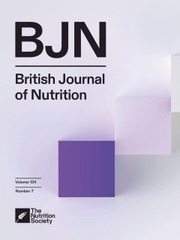Article contents
Effect of zinc supplementation on in vitro copper-induced oxidation of low-density lipoproteins in healthy French subjects aged 55–70 years:the Zenith Study
Published online by Cambridge University Press: 08 March 2007
Abstract
Zn has been shown to possess antioxidant properties in vitro and in vitro. As inadequate dietary Zn intake has been reported in these populations, Zn supplementation may protect against oxidative stress and thereby limit the progression of degenerative diseases in such populations. We conducted the present study to evaluate the long-term supplementation effects of two moderate doses of Zn on in vitro Cu-induced LDL oxidation in French men and women.Three groups of sixteen healthy subjects aged 55–70 years from each sex participated in this randomized double-blind, placebo-controlled study. Each group received for six months either 0, 15 or 30mg supplemental Zn per d. At the beginning and at the end of the supplementation periods, dietary intakes of Zn, Cu, Fe and vitamin E were estimated using 4d food-intake records (including the weekend) and the GENI program. Zn, Cu, Fe and vitamin E statuswere also determined. In vitro LDL oxidizability (basal conjugated diene level, maximal conjugated diene formation and lag time) and lipid parameters were also determined. Dietary intakes of Zn, Cu, Fe and vitamin E were adequate in this population. Zn supplementation significantly increased serum Zn levels but did not significantly modify Cu, Fe or vitamin E status. However, Zn supplementation had no effect on in vitro LDL oxidation parameters, nor were there any sex-related differences in in vitro LDL oxidizability. The present study showed that long-term Zn supplementation of healthy subjects aged 55–70 years had no effect on in vitro Cu-induced LDL oxidation under the study conditions.
- Type
- Research Article
- Information
- Copyright
- Copyright © The Nutrition Society 2006
References
- 14
- Cited by


